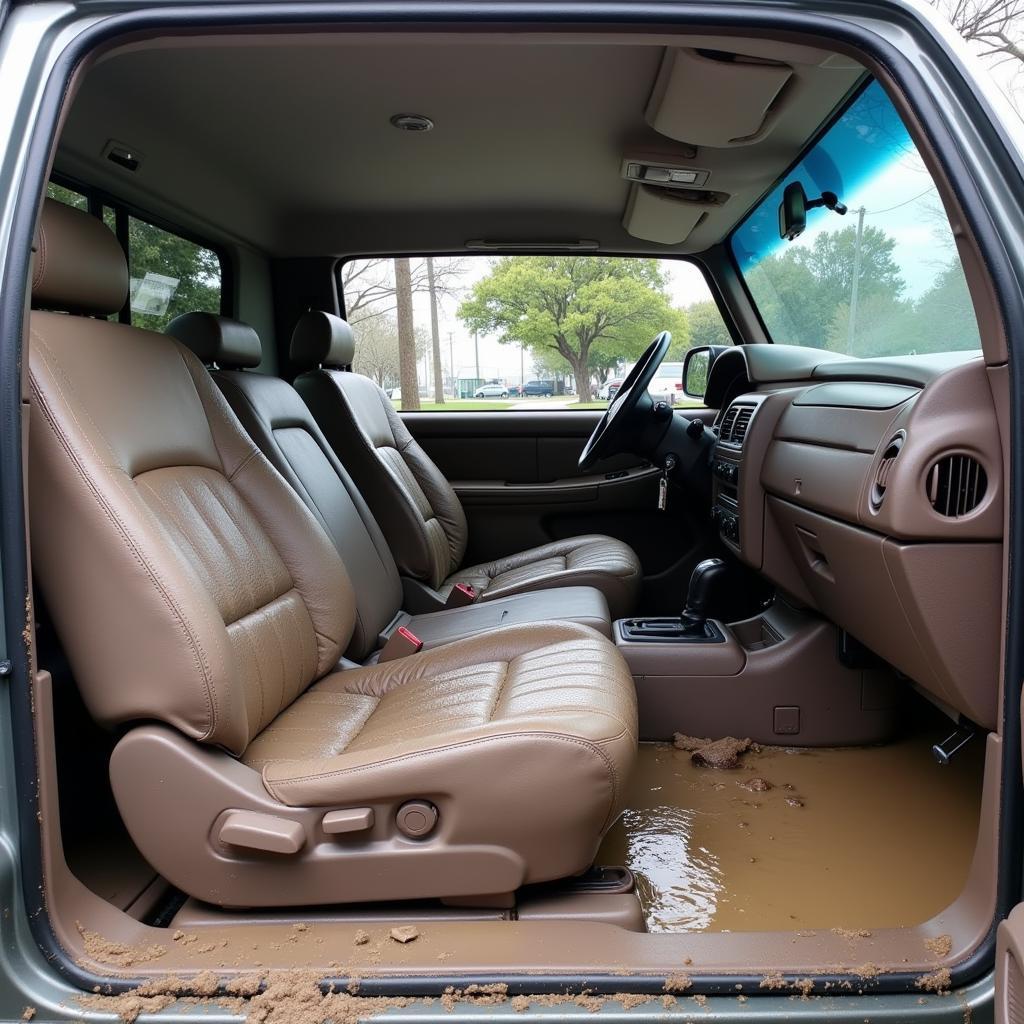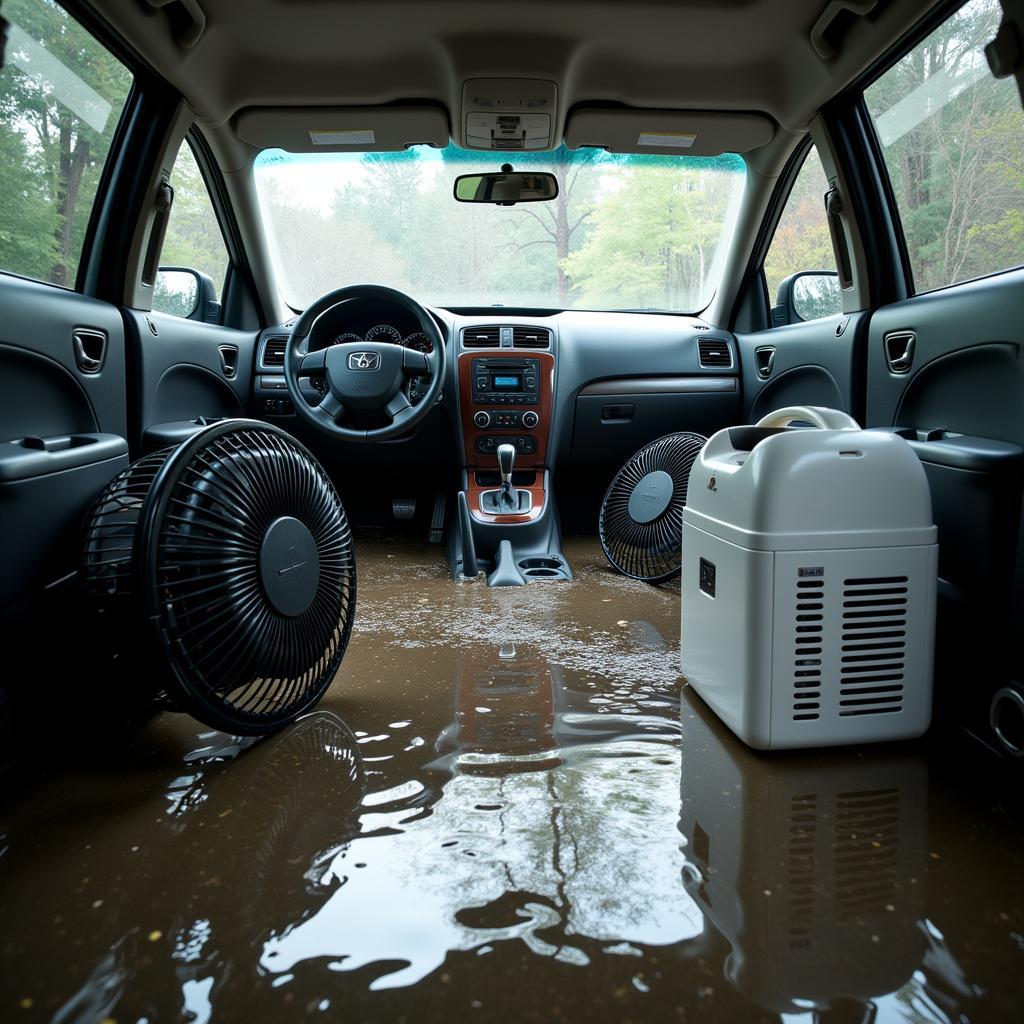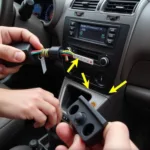Dealing with a flooded car can be a daunting experience. Whether it’s from a natural disaster, a burst pipe, or accidentally driving through deep water, understanding How To Repair A Flooded Car is crucial. This guide will provide you with a step-by-step process to assess the damage and potentially salvage your vehicle.
First, disconnect the car battery. This is an essential safety precaution to prevent electrical shocks and further damage to the electrical system. Next, document the damage extensively with photographs and videos for insurance purposes. It’s also a good time to contact your insurance company to report the incident and understand your coverage. Check is flood damage car repairable to see if your car is salvageable.
Assessing the Flood Damage: Interior and Exterior
Thoroughly inspect both the interior and exterior of your car. Look for visible signs of water damage, such as water lines, mud, debris, and discoloration. Pay particular attention to the engine compartment, undercarriage, and electrical components. If the water level reached the dashboard or higher, the damage is likely extensive and might exceed the car’s value.
Remember, floodwater isn’t just water. It often contains contaminants like sewage, chemicals, and salt, which can corrode metal parts and cause long-term issues. This is why a quick assessment is critical in determining the extent of the problem.
 Assessing flood damage to a car's interior
Assessing flood damage to a car's interior
How to Dry Out a Flooded Car
Drying the car thoroughly is the next step. Remove all standing water using a wet/dry vacuum. Then, remove all carpets, floor mats, and upholstery. These items are often saturated and can harbor mold and mildew. If the water level was high, consider removing the seats as well.
Open all doors and windows to allow for air circulation. Use fans and dehumidifiers to expedite the drying process. In some cases, professional water damage restoration services might be necessary, especially if the flooding involved contaminated water. You may need to know how to repair water drown car for further guidance.
 Drying a flooded car's interior using fans and dehumidifiers
Drying a flooded car's interior using fans and dehumidifiers
Mechanical and Electrical Inspection
Once the car is dry, a thorough mechanical and electrical inspection is crucial. Check all fluids, including engine oil, transmission fluid, brake fluid, and power steering fluid. If the fluids appear milky or contaminated, they must be replaced. Inspect the air filter, belts, hoses, and other engine components for damage.
The electrical system is particularly vulnerable to water damage. Check all wiring, connectors, and electronic control units (ECUs) for corrosion and damage. Faulty electrical components can lead to various problems, including starting issues, malfunctioning lights, and even electrical fires. Consider consulting a qualified mechanic specializing in flood-damaged vehicles for a comprehensive evaluation. It’s always a good idea to know how to repair car brakes as brake systems are also vulnerable.
Cleaning and Disinfecting
After the mechanical and electrical systems are addressed, thoroughly clean and disinfect the interior. Use a specialized cleaner designed for automotive interiors and pay attention to all surfaces, including the dashboard, steering wheel, door panels, and center console. Disinfecting is especially important if the flood involved contaminated water.
 Cleaning and disinfecting a flooded car's interior
Cleaning and disinfecting a flooded car's interior
Can a Flooded Car Be Repaired?
The decision to repair a flooded car depends on the extent of the damage and the cost of repairs. In some cases, the cost of repairs might exceed the car’s value, making it more economical to declare it a total loss. However, if the damage is relatively minor and the cost of repairs is reasonable, repairing the car might be a viable option. See if your car falls under the category of can a flood hit car be repaired. Sometimes, even if repairable, it might be wise to learn can we repair dead car battery as the battery is most likely damaged.
In conclusion, repairing a flooded car is a complex process that requires careful assessment, thorough cleaning, and meticulous mechanical and electrical inspection. By following these steps and seeking professional help when necessary, you can increase your chances of successfully restoring your vehicle after a flood.
FAQ
- Is it safe to drive a flooded car? No, it’s not safe to drive a flooded car immediately. It requires a thorough inspection and repairs.
- How long does it take to repair a flooded car? The repair time varies depending on the extent of the damage.
- Will insurance cover flood damage? It depends on your specific insurance policy.
- How can I prevent flood damage to my car? Avoid parking in flood-prone areas and move your car to higher ground during heavy rains.
- What are the long-term effects of flood damage on a car? Corrosion, electrical problems, and mold growth are common long-term issues.
- Should I buy a used car that has been flooded? Exercise extreme caution. Flooded cars can have hidden problems.
- How do I know if a used car has been flooded? Look for signs of water damage, such as rust, mildew, and discoloration.
Need help with your car? Contact us via WhatsApp: +1(641)206-8880, Email: [email protected]. We have a 24/7 customer support team ready to assist you.


